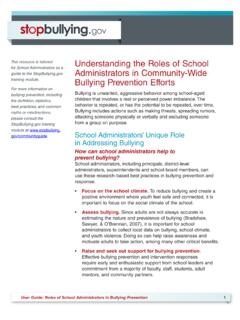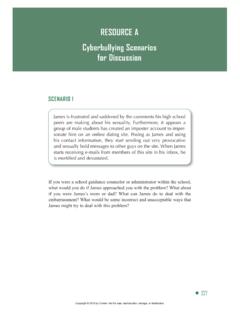Transcription of BULLYING PREVENTION IN MIDDLE SCHOOL
1 BULLYING PREVENTION IN MIDDLE SCHOOL Established in 1989, Communities In Schools of North Carolina (CISNC) is part of the national Communities In Schools network. CISNC combines the art of one-on-one relationships with the science of proven evidence-based programs to achieve results and remove barriers that keep students succeeding in SCHOOL and life. Working with affiliates across nearly half of the state s counties, CISNC employs an ABC+P model designed to increase attendance, improve behaviors, advance coursework, and foster parent and SCHOOL partnerships in their child s academic success. CISNC serves more than 230,000 students annually. The Nonprofit Evaluation Support Program (NESP) is a collaborative effort between two University of North Carolina Greensboro organizations The SERVE Center and The Office of Assessment, Evaluation, and Research Services (OAERS). NESP s mission is to provide program evaluation services and program evaluation capacity building support to nonprofit and community-based organizations while providing authentic learning experiences for future leaders in the field of program evaluation.
2 The SERVE Center at The University of North Carolina Greensboro is a university-based research, development, dissemination, evaluation, and technical assistance center. For more than 24 years, SERVE Center has worked to improve K-12 education by providing evidence-based resources and customized technical assistance to policymakers and practitioners. The University of North Carolina Greensboro (UNCG) is one of the sixteen university campuses of The University of North Carolina. UNCG holds two classifications from the Carnegie Foundation for the Advancement of Teaching, as a research university with high research activity and for community engagement in curriculum, outreach, and partnerships. Copyright 2015. Communities In Schools of North Carolina (CISNC). All rights reserved. No portion of this document may be copied or reproduced in whole or in part without the express permission of Communities In Schools of North Carolina. Communities In Schools of North Carolina 222 North Person Street, Suite 203 | Raleigh, NC 27601 Phone: (919) 832-2700 | Toll Free: (800) 849-8881 | Fax: (919) 832-5436 BULLYING PREVENTION IN MIDDLE SCHOOL Table of Contents Overview.
3 1 CISNC Introduction .. 1 Using Evidenced-Based Strategies .. 1 2 Purpose .. 3 Implementation Plan .. 3 Uses .. 3 Audiences .. 3 3 Materials/Equipment/Space .. 5 Time .. 5 Lesson Plan of Activity .. 5 Sample Lesson Give and Expect Respect .. 5 Tier 2 Intervention and Support Examples .. 7 Resources .. 8 Measuring Success .. 11 Appendix A: Glossary .. A-1 Appendix B: References .. B-1 Appendix C: Research C-1 1 BULLYING PREVENTION IN MIDDLE SCHOOL Overview CISNC Introduction In the 2014-2015 SCHOOL year, Communities In Schools of North Carolina (CISNC) introduced a framework that aligns site and student metrics and interventions and supports to four areas that have been shown to have the greatest impact on student success: attendance, behavior, coursework, and parent involvement, or ABC+P. Both combined and individually, attendance, behavior, and coursework are among the best predictors of a student s academic success and on-time graduation. While collecting data around ABC+P is critically important to understanding the SCHOOL and student, it is even more important to use the data to drive high impact intervention and support delivery to empower each student to reach their full potential.
4 To this end, Communities In Schools of North Carolina has partnered with the SERVE Center at the University of North Carolina at Greensboro to design curricula specifically for CIS within the ABC+P framework to enhance student outcomes in SCHOOL and success in life. This document is one of more than 50 modules developed to support local CIS staff and most importantly the students that are served. We encourage you to explore all of the modules available online at Using Evidenced-Based Strategies There are a multitude of strategies that claim to address student behavior, but there are few that actually do so for all students. We suggest that schools use an evidence-based, decision-making model to ensure that high quality information informs the decisions made. The Institute of Education Sciences (IES) at the Department of Education defines evidence-based decision making as routinely seeking out the best available information on prior research and recent evaluation findings before adopting programs or practices that will demand extensive material or human resources (including both funding and teacher time) and/or affect significant numbers of students (Whitehurst, 2004).
5 Evidence-based practice means delivering interventions and supports to students (clients) in ways that integrate the best available evidence from data, research, and evaluation; professional wisdom gained from experience; and contextual knowledge of the particular classroom, SCHOOL , district, or state that might impact the design or implementation. The ABC +P framework is inextricably bound; challenges in one area can lead to challenges in another and often exacerbate a student s issues. This document focuses on student behavior, in particular, a problem behavior. Wang and Fredricks (2014) state, ..problem behaviors often elicit negative interpersonal interactions with teachers and parents, in turn leading to aggravated disengagement from SCHOOL (Bachman et al., 2008). Association with deviant peers also provides incentives for truancy and a devaluing of academic achievement (Wang & Dishion, 2012). When students are not engaged, the risk of them becoming involved in disruptive behaviors like truancy, substance abuse, gangs, delinquent behavior and others are higher; and participation in those activities weakens the bonds to 2 BULLYING PREVENTION IN MIDDLE SCHOOL their SCHOOL environment and families (Steward, Steward, Blar, Jo & Hill, 2008; Wang & Fredricks, 2014).
6 While the terminology may differ across fields, the challenge boils down to a disconnect between students and their schools; this module provides an example of a strategy that will reconnect students to their schools, address students challenging behaviors, and hopefully make schools safer, supportive, and engaging. Problem/Rationale BULLYING is repeated, unwanted aggressive behavior against a victim where there is an observed or perceived imbalance of power (Centers for Disease Control, 2013), and it is prevalent in our nation s schools. BULLYING can take the form of physical aggression ( , hitting), verbal abuse ( , name calling), relational/social rejection ( , gossiping or excluding from groups) and cyberbullying ( , intimidation or aggression toward others through text messaging, social media, etc.). In 2013, 20% of students reported being bullied in SCHOOL and 15% reported being cyber-bullied (Centers for Disease Control, 2014). Additionally, cyberbullying is reported to occur simultaneously with other types of BULLYING (Waasdorp & Bradshaw, 2015).
7 BULLYING has been reported to occur more frequently among MIDDLE SCHOOL students, and more specifically among sixth graders (Nansel, Overpeck, Pilla, Ruan, Simons-Morton, & Scheidt, 2001). Students can be victims of BULLYING , perpetrators or both (called bully-victim ). Victims of BULLYING may struggle to adjust in SCHOOL , resulting in increased absenteeism, and are at increased risk for depression, anxiety, trouble sleeping and low self-esteem (Nansel et. al., 2001). Moreover, students who bully other students are at increased risk for academic problems, violence and substance abuse (Radliff, Wheaton, Robinson & Morris, 2012). In addition to good parental support (Wang, Iannotti & Nansel, 2009), research suggests that broader SCHOOL -wide programs that seek to alter student behavior have been the most promising in reducing the prevalence of BULLYING in schools (Limber, 2003). In other words, schools that provide a safe learning environment and model positive behavior among adults can reduce incidences of BULLYING in their schools (Klein, J.)
8 , Cornell, D., & Konold, T., 2012). Anti- BULLYING campaigns, one of the most commonly employed SCHOOL -based strategies to reduce BULLYING and victimization, has on average decreased BULLYING by 20-23% and victimization by 17-20% (Farrington & Ttofi, 2009). The current literature identifies five essential elements or research-based approaches of effective youth interventions/ PREVENTION programs: A structured curriculum A program or strategy that teaches new skills. Activities that allow youth to practice new skills in active ways ( , discussions, role-playings, etc.). Involves a SCHOOL -wide or community approach. 3 BULLYING PREVENTION IN MIDDLE SCHOOL Incorporates high level of adults participation and support (Jones, Doces, Swearer & Collier, 2013) Purpose The purpose of this document is to focus on one easy to implement BULLYING PREVENTION strategy that can be used in MIDDLE schools. Teachers and SCHOOL staff can promote a safe, positive SCHOOL climate and encourage positive student behavior with: Instruction on the SCHOOL s code of conduct and positive social skills Additional strategies to promote a safe, positive SCHOOL -wide climate Tools and resources to share with parents Implementation Plan Uses Teachers can use the information provided in this guide to help students understand the importance of a safe, positive SCHOOL environment, the importance of respecting others, and how to prevent and respond to BULLYING in SCHOOL .
9 Audiences The primary audience for the lesson is MIDDLE SCHOOL students. Activities Below are several activities schools can implement to motivate and reinforce positive behavior in SCHOOL . The activity highlighted is designed to teach students the importance of respecting and treating others fairly. SCHOOL -wide Use evidence-based decision making. o Refer to the curriculum guide on monitoring data. Establish clear SCHOOL rules about BULLYING and monitor the occurrence of BULLYING in the SCHOOL . o Establish contact person(s) who students can feel free to talk to about BULLYING incidents. Establish staff protocol for handling BULLYING reports. Follow-up with students who have been bullied. Hang posters throughout hallways that reinforce SCHOOL rules and policies regarding BULLYING . Collaborate with community partners to sponsor a Bully-Free SCHOOL back to SCHOOL rally at the beginning the SCHOOL year. o Invite local celebrities, community partners and other youth to speak.
10 4 BULLYING PREVENTION IN MIDDLE SCHOOL o Work with popular radio stations to develop youth focused commercials/PSAs. o Include activities for the entire family. Praise students who make good decisions to help someone who is being bullied or chooses not to participate in BULLYING activities. o Send home postcards Your child made the right choice. Conduct a one-day training for all staff. o Recognizing and addressing BULLYING in SCHOOL . o Communicating with parents of victims and/or aggressors. o Modeling appropriate adult behavior in SCHOOL . Increase supervision in places where BULLYING may occur ( , playground, hallways, cafeteria, bus line, etc.) Classroom Introduce SCHOOL /class rules and social skills that promote a safe, positive SCHOOL climate. Talk to students regularly about how to manage their emotions, behaviors and friendships with other students. Involve parents Hold parent meetings/workshops on BULLYING /cyberbullying o Share SCHOOL policies and procedures regarding BULLYING .







